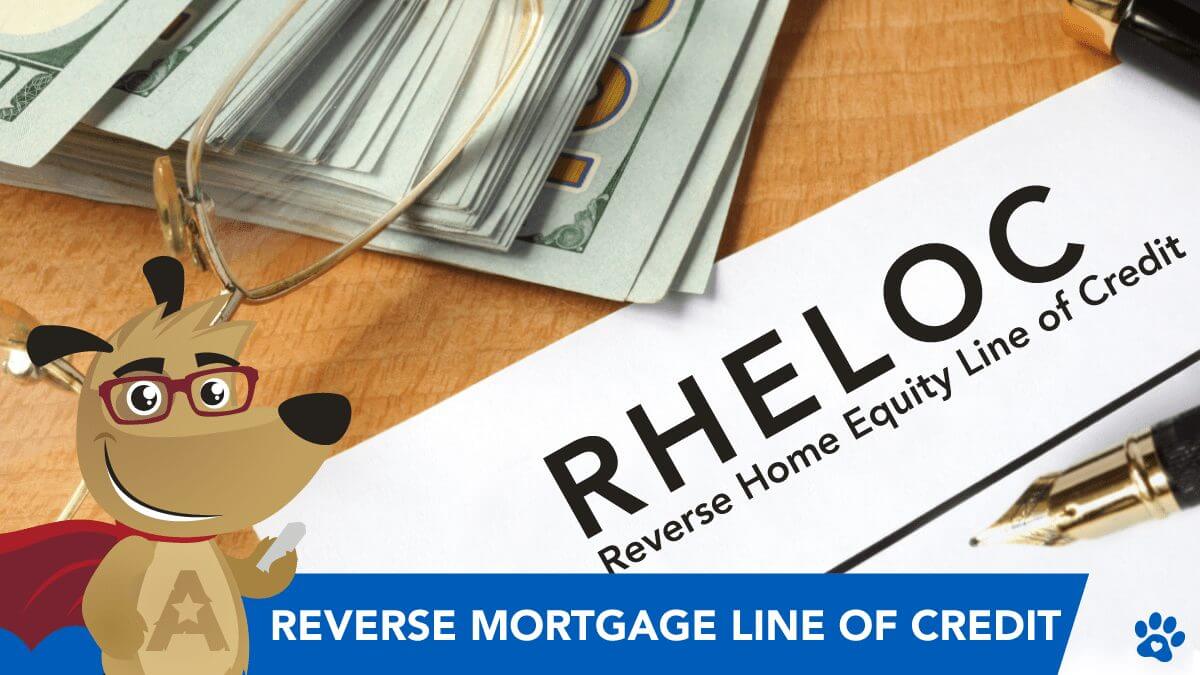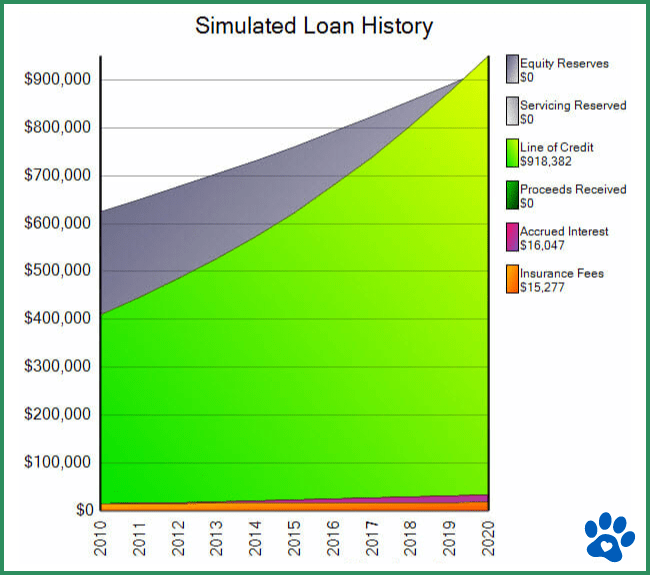
REVERSE MORTGAGE LINE OF CREDIT

 |
ARLO™REVERSE MORTGAGE
ASSISTANT |
Reverse Mortgage Line of Credit & Growth Rate Explained
 |
Michael G. Branson, CEO of All Reverse Mortgage, Inc., and moderator of ARLO™, has 45 years of experience in the mortgage banking industry. He has devoted the past 20 years to reverse mortgages exclusively. (License: NMLS# 14040) |
 |
All Reverse Mortgage's editing process includes rigorous fact-checking led by industry experts to ensure all content is accurate and current. This article has been reviewed, edited, and fact-checked by Cliff Auerswald, President and co-creator of ARLO™. (License: NMLS# 14041) |

Reverse Mortgage Line of Credit: Why It’s the Most Popular Option
The reverse mortgage line of credit remains the most popular choice among homeowners today—and for good reason. According to a report by AARP, 66% of borrowers chose the line of credit as the best way to access their reverse mortgage funds.
Why So Many Homeowners Choose the Line of Credit
The reverse mortgage line of credit gives you flexibility and control. When your loan closes, you can access up to the maximum amount allowed by HUD during the first 12 months. After that, any remaining funds become available—and you can use them as needed, when needed.
Unlike other loan types, you’re not required to take all your money upfront. You decide how much to use and when, which helps with long-term financial planning.
So, why do so many borrowers choose this option—even though it’s only offered at an adjustable interest rate?
The Answer: Flexibility
With a line of credit reverse mortgage:
-
You can withdraw funds over time, not all at once.
-
You pay interest only on the money you actually use.
-
The unused funds grow over time, increasing your available credit.
Why Fixed-Rate Reverse Mortgages Are Less Flexible
Some homeowners may consider a fixed-rate reverse mortgage, but it’s important to understand the trade-offs.
Fixed Rate = One-Time Lump Sum
The fixed-rate reverse mortgage only allows for a single lump-sum payout at closing. There is no line of credit option. If you need all the funds upfront—like to pay off an existing mortgage—this could work.
But if you want the freedom to access funds later, a fixed-rate reverse mortgage will not meet your needs.
Benefits of a Line of Credit Reverse Mortgage
In contrast, the line of credit gives you several unique benefits:
-
Partial withdrawals at closing, with the rest available over time
-
No interest accrues on the unused portion
-
The line of credit grows monthly based on current rates
-
You’re protected by federal mortgage insurance
Federally Insured Line of Credit = Long-Term Security
The HECM line of credit (Home Equity Conversion Mortgage) comes with a special advantage: it can never be frozen or closed by the lender as long as you meet basic obligations.
Even during market downturns or credit freezes, your line of credit stays in place. This is not true for traditional HELOCs (home equity lines of credit), which can be reduced or frozen by banks at any time.
You’ve paid for FHA mortgage insurance to guarantee that access to your funds is protected—even when markets shift.
Just remember: You must continue living in your home, pay your property taxes and insurance, and keep the home in reasonably good condition.
Growth Rate Feature
Another significant feature of the line of credit reverse mortgage is the credit line growth rate.
I have often heard this mischaracterized as interest earned, which it is not. Still, the unused portion of the credit line grows at the same rate at which the loan accrues interest, plus the Mortgage Insurance Premium (MIP) renewal.

How the Reverse Mortgage Line of Credit Grows (Example)
Let’s walk through a simple example to show how your unused funds can grow over time.
Suppose today’s interest rate (known as the fully indexed accrual rate) is 6.00%, and you add the Mortgage Insurance Premium (MIP) renewal rate of 0.50%. That gives you a total effective growth rate of 6.50% annually.
Now, imagine your available loan amount—after closing costs and calculations—is $350,000. If you don’t use these funds right away, your line of credit will start growing automatically, month by month.
Here’s what that looks like:
Estimated Line of Credit Growth Over Time
| Time Period | Estimated Credit Line Value |
|---|---|
| Month 1 Growth | $1,895.83 |
| After 5 Years | $516,399 |
| After 10 Years | $714,086 |
This growth happens because your available credit increases based on the unused balance and current interest rate. If you use some of the funds, the growth will adjust accordingly, but as long as there’s a remaining balance, the line continues to grow.
And here’s an added benefit: if interest rates rise in the future, your line of credit grows even faster—helping you hedge against inflation.
Why It’s Better Than a HELOC
A reverse mortgage line of credit shares some features with a traditional Home Equity Line of Credit (HELOC)—but with key advantages:
-
No monthly payments required
-
No lender can freeze or cancel the loan (as long as you continue to live in the home, pay your property taxes and insurance, and maintain the property)
-
Only pay interest on the money you actually borrow
-
Your available credit grows over time—a feature HELOCs don’t offer
Bottom Line
The reverse mortgage line of credit is more than just a way to access home equity—it’s a powerful financial planning tool that grows over time and gives you long-term flexibility. For many older homeowners, it offers the security and control that traditional loans can’t.
2025 Reverse Mortgage Line of Credit vs. HELOC: Which Fits You?
Feature Reverse Mortgage Credit Line Traditional HELOC
Monthly Payments Needed? No Yes
Balloon Payment After 10 Years? No Yes
Hard to Qualify on Fixed Income? No Yes
Minimum Credit Score Required? No Yes
Adjustable Rate? Yes Yes
Guaranteed Growth Rate? Yes No
Prepayment Penalty? No No
Want a LOC That Grows? Get your custom reverse mortgage quote with free growth projections from All Reverse Mortgage—America’s #1 with a 4.99/5-star rating! Call (800) 565-1722 or click for your free quote now—simple and trusted!
Line of Credit FAQs
What is a HECM line of credit?
Which is better, a home equity line of credit or a reverse mortgage?
How does a reverse mortgage line of credit grow?
The HECM line of credit comes with a guaranteed growth rate. The Growth Rate equals your current interest rate + the mortgage insurance rate (currently 0.50% as of February 2025). Each month, the growth rate is applied to your unused portion of the line of credit. Growth rate example: Customer has a HECM loan with a $75,000 available unused line of credit. The hypothetical interest rate of 4%, and a MIP rate of 0.50%. Each month, the 4.5% combined rate will be applied to the unused line of credit figure. $75,000 x .0450 = $3,375. $3,375/12 = $281.25 in line of credit growth for the next month. This calculation is performed each month based on how much remains in the line of credit.
If you already have a reverse mortgage, can you get a Home Equity Line of Credit (HELOC)?
How is the interest charged on a reverse mortgage line of credit?
The interest is charged on a reverse mortgage monthly and added to the outstanding balance. The formula for calculating interest is a simple interest formula. Interest Example: Customer has a HECM loan with an outstanding balance of $50,000 and a hypothetical interest rate of 4%. $50,000 x 0.040 = $2,000. $2,000/12 = $166.67 in interest added to the loan’s outstanding balance. Each month, this calculation is performed based on the outstanding loan balance.
Key Takeaways: Why the Reverse Mortgage Line of Credit Stands Out
-
Most Popular Option
Thanks to its flexibility, the reverse mortgage line of credit is the most commonly chosen payment plan among borrowers. -
Interest Only on What You Use
Like a traditional Home Equity Line of Credit (HELOC), you only pay interest on the money you’ve actually borrowed—not on the total available credit. -
Ideal for Retirees on Fixed Incomes
With no monthly mortgage payments, no set repayment schedule, and no risk of lender call dates, this option is especially helpful for retirees looking for peace of mind. -
Built-In Growth Over Time
Any unused funds in your line of credit continue to grow monthly. This is known as the growth rate, and it gives you more available funds over time—helping you hedge against inflation.


ARLO recommends these helpful resources:

 Michael G. Branson
Michael G. Branson Cliff Auerswald
Cliff Auerswald

July 8th, 2024
July 13th, 2024
October 17th, 2023
October 17th, 2023
November 26th, 2023
December 4th, 2023
July 30th, 2023
July 30th, 2023
August 11th, 2023
September 3rd, 2023
March 8th, 2023
March 14th, 2023
June 27th, 2022
June 30th, 2022
May 2nd, 2022
May 2nd, 2022
April 24th, 2022
May 2nd, 2022
September 17th, 2021
September 22nd, 2021
August 5th, 2021
August 10th, 2021
July 17th, 2021
July 24th, 2021
July 25th, 2021
July 25th, 2021
August 2nd, 2021
August 22nd, 2021
July 30th, 2021
August 2nd, 2021
May 4th, 2021
May 4th, 2021
April 5th, 2021
April 7th, 2021
January 11th, 2021
January 11th, 2021
March 16th, 2020
March 16th, 2020
July 25th, 2020
July 27th, 2020
December 6th, 2019
December 14th, 2019
November 20th, 2019
November 20th, 2019
November 11th, 2019
November 11th, 2019
October 28th, 2019
October 28th, 2019
October 27th, 2019
October 27th, 2019
October 15th, 2019
October 15th, 2019
October 11th, 2019
October 11th, 2019
September 23rd, 2019
September 23rd, 2019
September 4th, 2019
September 4th, 2019
June 13th, 2019
May 1st, 2019
May 1st, 2019
April 1st, 2019
April 1st, 2019
March 28th, 2019
March 28th, 2019
March 19th, 2019
March 19th, 2019
August 28th, 2018
June 29th, 2018
June 29th, 2018
June 20th, 2018
June 20th, 2018
May 21st, 2018
May 21st, 2018
January 11th, 2018
January 23rd, 2018
August 28th, 2017
August 28th, 2017
July 19th, 2017
July 19th, 2017
June 19th, 2017
June 19th, 2017
April 6th, 2017
April 6th, 2017
March 24th, 2017
March 24th, 2017
February 16th, 2017
February 16th, 2017
January 24th, 2017
January 24th, 2017
August 30th, 2016
August 30th, 2016
June 24th, 2016
June 24th, 2016
June 1st, 2016
June 1st, 2016
June 1st, 2016
June 1st, 2016
May 26th, 2016
May 27th, 2016
May 27th, 2016
January 5th, 2016
January 5th, 2016
May 7th, 2015
May 7th, 2015
July 7th, 2014
July 8th, 2014
August 6th, 2013
August 12th, 2013
August 3rd, 2013
August 5th, 2013
August 16th, 2012
August 16th, 2012
July 4th, 2012
May 22nd, 2012
May 22nd, 2012
May 7th, 2012
April 11th, 2012